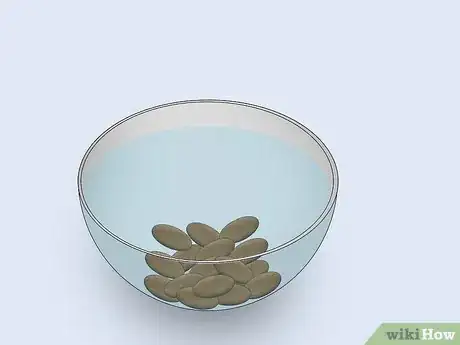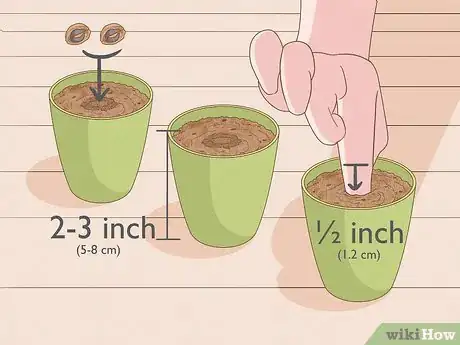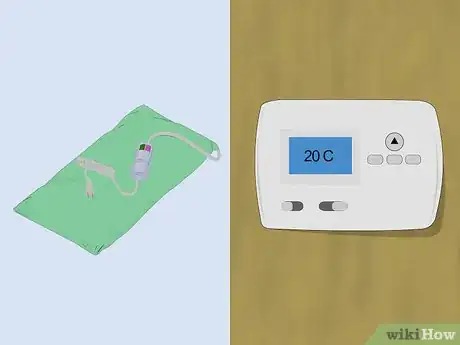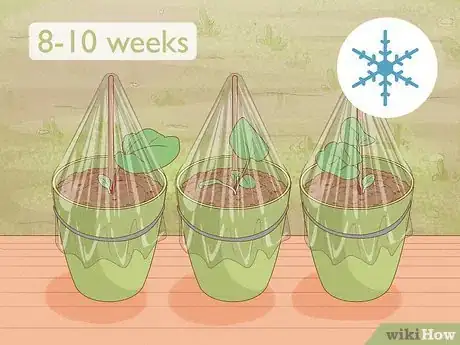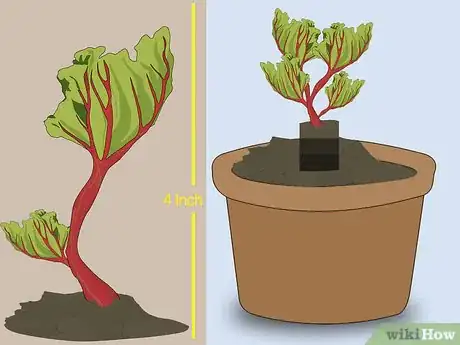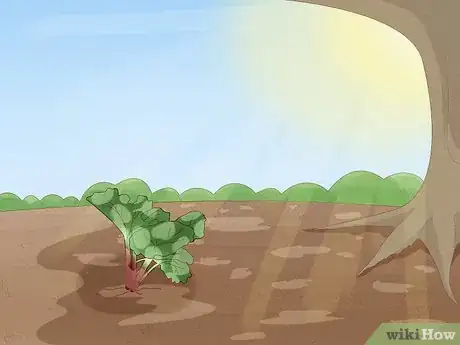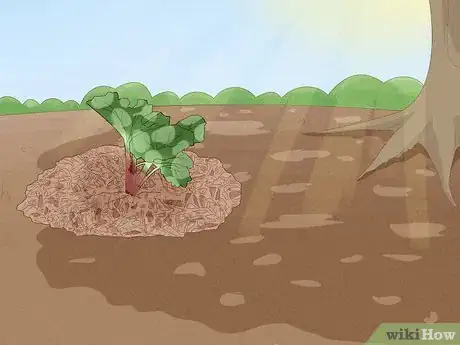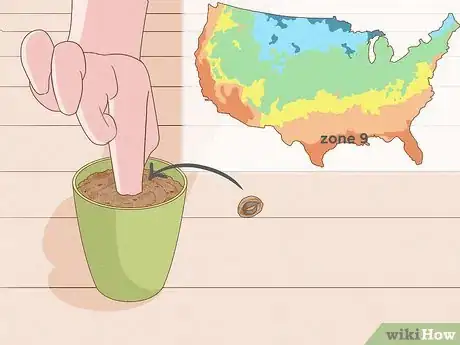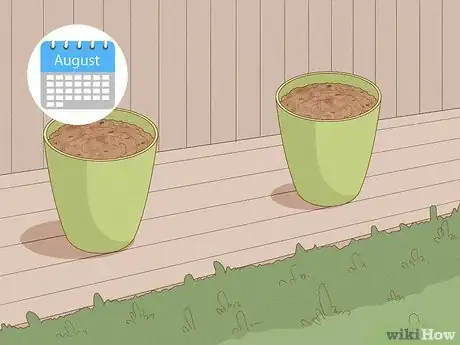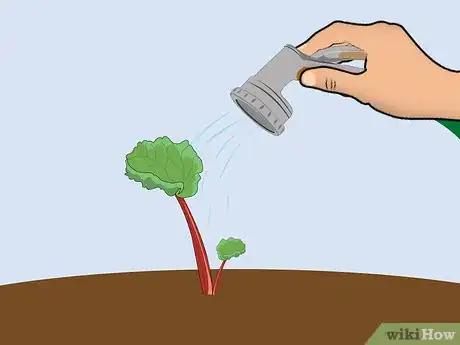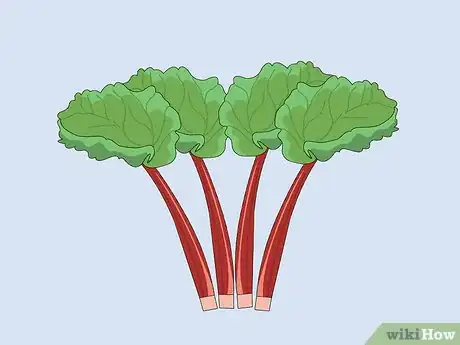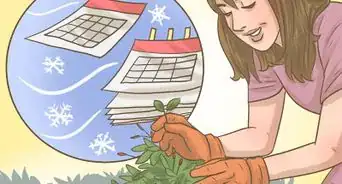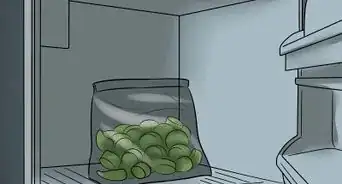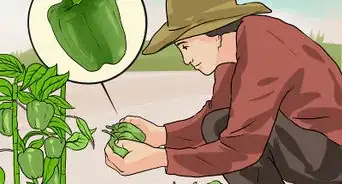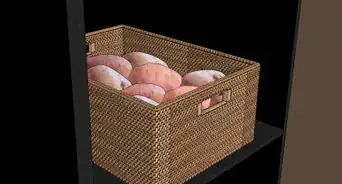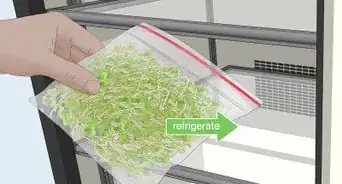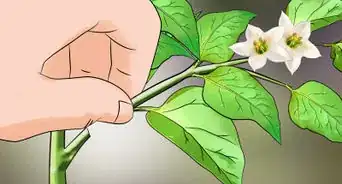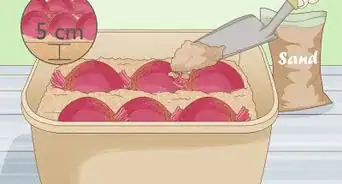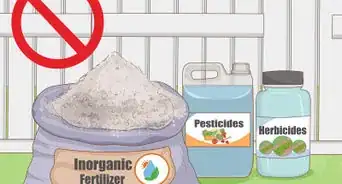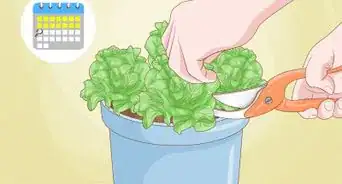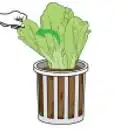This article was co-authored by Andrew Carberry, MPH. Andrew Carberry is a Food Systems Expert and the Senior Program Associate at the Wallace Centere at Winrock International in Little Rock, Arkansas. He has worked in food systems since 2008 and has experience working on farm-to-school projects, food safety programs, and working with local and state coalitions in Arkansas. He is a graduate of the College of William and Mary and holds a Masters degree in public health and nutrition from the University of Tennessee.
There are 8 references cited in this article, which can be found at the bottom of the page.
This article has been viewed 36,501 times.
Growing rhubarb from a seed takes considerably more time than growing it from a crown or cutting, but it can be a cheaper and easier way to start a large crop. In cool climates you can grow rhubarb as a perennial, which can be harvested year after year, or you can grow it as an annual, which is recommended in warmer areas.
Steps
Starting the Seeds
-
1Soak your seeds in water. Rhubarb seeds are covered in a paper-like shell. Soaking the seeds for 1-2 hours before planting will prepare them for germination so that they begin rooting sooner.
-
2Create a potting soil mix. Mix equal parts peat moss, vermiculite, and compost to make your own basic potting mix.
- Rhubarb does best in moderately acidic soil (pH 6.0 to 6.8). You can use a pH test kit or other methods to test the soil acidity.
Advertisement -
3Place the rhubarb seeds into pots. Use a small, 2-3 inch (5-8 cm) pot or starter tray with drainage holes on the bottom. Fill the pots or trays with your soil mixture. Using your finger, dig a small hole about ½ inch (1.2 cm) deep. Place 2 seeds in the hole, then cover them with dirt and water them.
- Use peat pots or cow pots to make transplanting easier.
- Keep the soil evenly moist, watering when necessary. Do not overwater, as this can drown the seeds.
-
4Keep the seeds warm. If the room temperature is below 70 °F (21.1 °C) (21 C), you can use a heating table or heating mat to speed the process.
Growing Rhubarb as a Perennial
-
1
-
2Cover your planted seeds 8-10 weeks before the final frost. Your growing seedlings need to be protected from the cold temperatures, so make sure that you put a protective cover overtop of them in this early stage while they’re fragile. Do this at least two months before your area’s estimated final frost of the year.[3]
-
3Harden the plants off before transplanting them. Harden off your plants by taking them outside little by little to get used to the sun, rain, and cold before exposing them to the elements permanently.[4]
-
4Transplant the plants to the garden 2 weeks before the last frost. The plants should be about 4 inches tall at this point, so they’re ready to be transplanted. Remove the plants from their pot. Carefully tip the pots upside down to remove the plant and root ball. Dig a hole twice as wide and at least as deep as the pot your rhubarb is in.[5]
- If the plant doesn’t come out with a little squeeze to the sides of the pot, you can use a butter knife to cut around the soil. It also helps to water the plants about an hour before your remove them from their pots.
- If you used a peat pot or a cow pot you can simply place the pot with the plant into the soil.
-
5Transport the plants to a shaded area. Prepare a suitable part of the garden. Choose somewhere cool that the rhubarb can happily grow at its own pace. Clear out enough space in the ground so that you can plant the roots 36-48 inches (90-120 cm) apart. Planting any closer together will crowd the plants.
- In warmer climates it is important to find shade for your plants during hotter months. You can plant the rhubarb by tall shade plants (tomatoes, pole lima beans), or create shade with a shade cloth.[6]
-
6Use mulch to evenly distribute moisture. In order to allow your plants to thrive, you’ll need to keep them consistently and evenly moist. They’ll die if the sun dries their roots out. Mulching will keep the rhubarb roots properly cool and moist.[7]
Growing Rhubarb as an Annual
-
1Grow as an annual if you live in zone 9 or higher. Rhubarb can grow perennially in most areas of the U.S., but places like southern California, Texas, and Florida may only be able to grow rhubarb annually.[8]
-
2Start your seeds in August in a shady location. Rhubarb doesn’t do well in intense heat, so once you’ve soaked the seeds and planted them in a soil-filled pot, you’ll need to find a shady area for them. Either put the pot in a shaded spot outdoors or keep the pot indoors. This way, the seeds will stay healthy during hotter months as they’re growing into plants.
-
3Transplant the plants to the garden once they’re 4 inches (10.2 cm) tall. Transplant the plants to the garden after about 30 days in the pot. At this point, they should be about 4 inches tall. Carefully tip the pots upside down until the plant and root ball slide out. Dig a hole that’s twice as wide as the plant. Plant the root balls as deep as they were in their pots.
- To get the plants out of the pot, it helps if you water them an hour or so beforehand. If the root ball doesn’t come out with a little squeeze to the sides of the pot, you can use a butter knife to cut around the soil.
- If you used a peat pot or a cow pot you can simply place the pot with the plant into the soil.[9]
- To avoid overcrowding the plants, clear out enough space in the ground so that you can plant the seeds 36-48 inches (90-120 cm) apart.
- Consider planting the rhubarb on a raised bed or in a hillside to avoid drainage issues.[10]
Harvesting the Rhubarb
-
1Water your plants regularly. It is essential to keep the soil evenly moist, so keep a close eye on your plants in the summer for signs of withering, yellowing, or dry soil. For best results, water your plants in the morning.[11]
- Be careful not to overwater the plants, as they are susceptible to root rot. To avoid this, you can plant rhubarb on a hillside or on raised beds.
-
2Consider growing rhubarb from a crown while you wait. Because a rhubarb crop can take several years to become established, you might want to grow a couple of plants from a crown while your seeds grow, mature, and become harvestable.[12]
-
3Harvest perennial plants a few stalks at a time. Wait at least two years until you start harvesting your rhubarb so that the plant can become established. Pull off the stalks at soil-level. To keep the plant healthy, only take a few stalks at a time.[13]
- Only eat the stalks -- rhubarb leaves are toxic![14]
-
4Harvest your annual rhubarb between March and May. Areas that grow rhubarb annually tend to have severely hot summer temperatures. Make sure to harvest your rhubarb in the late spring before the heat has a chance to kill the crop.[15]
Community Q&A
-
QuestionPlanting seeds in a hot climate. If it takes 2 yrs to grow rhubarb, how is it possible to grow an annual crop? Is there a strategy?
 DonaganTop AnswererPlant some every year, and beginning in the second year you'll harvest some rhubarb.
DonaganTop AnswererPlant some every year, and beginning in the second year you'll harvest some rhubarb.
Warnings
- Do not eat the stems if they appear soft and mushy. It is possible for oxalic acid to migrate from the leaves to the stems during extreme cold.[18]⧼thumbs_response⧽
Things You'll Need
- Rhubarb seeds
- Potting soil and containers
- Area of the garden set aside
- Shade cloth, if sunny
References
- ↑ http://www.southernexposure.com/blog/2015/02/growing-rhubarb-from-seed/
- ↑ http://planthardiness.ars.usda.gov/PHZMWeb/
- ↑ http://www.southernexposure.com/blog/2015/02/growing-rhubarb-from-seed/
- ↑ http://www.southernexposure.com/blog/2015/02/growing-rhubarb-from-seed/
- ↑ http://www.almanac.com/plant/rhubarb
- ↑ http://www.southernexposure.com/blog/2015/02/growing-rhubarb-from-seed/
- ↑ http://www.southernexposure.com/blog/2015/02/growing-rhubarb-from-seed/
- ↑ https://gardenambition.com/growing-rhubarb-from-seed/
- ↑ https://gardenambition.com/growing-rhubarb-from-seed/
- ↑ https://gardenambition.com/growing-rhubarb-from-seed/
- ↑ http://www.gardeners.com/how-to/when-to-water/8108.html
- ↑ http://www.thompson-morgan.com/how-to-grow-rhubarb
- ↑ http://www.rhubarbinfo.com/growing
- ↑ https://medlineplus.gov/ency/article/002876.htm
- ↑ http://www.southernexposure.com/blog/2015/02/growing-rhubarb-from-seed/
- ↑ http://www.thompson-morgan.com/how-to-grow-rhubarb
- ↑ http://www.southernexposure.com/blog/2015/02/growing-rhubarb-from-seed/
- ↑ http://www.rhubarbinfo.com/growing
